A Robot's Lost City
A film essay about Studio Ghibli's Castle in the Sky and human-nature relationships at the root of technology
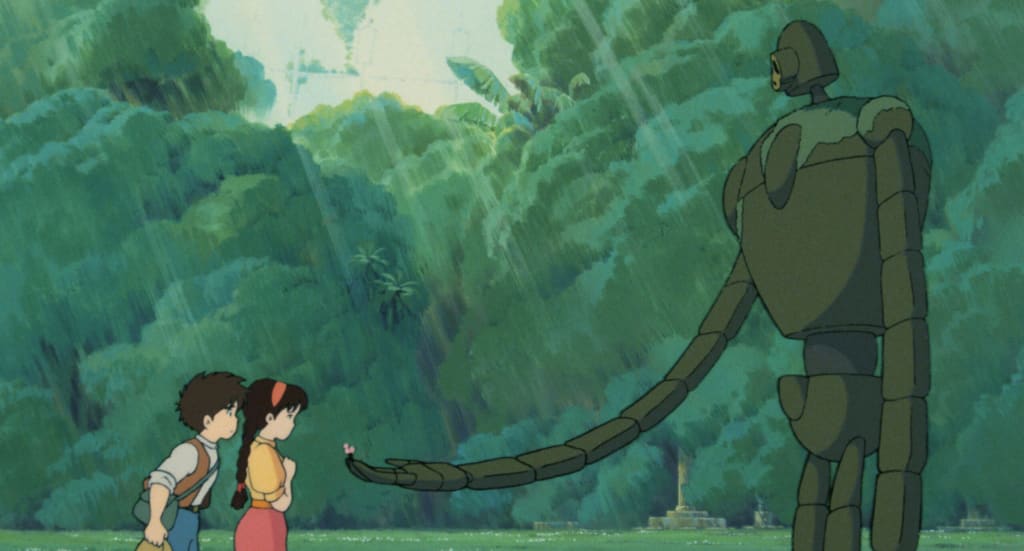
I have always been incredibly fascinated with the fact that Studio Ghibli films have a specific sense of nostalgia. I want to believe this is a sentiment for everyone who enjoys Ghibli films because, for me, they represent both a gleeful childhood and a vessel that allows us to find magical and meaningful moments as we grow older.
As an indecisive cinephile, when people ask about my favourite films, I have to break my answer down by category. Studio Ghibli has produced two of my top animated films, Howl’s Moving Castle and Castle in the Sky. In this film essay, I will be dissecting the latter, but I would love to peel back the layers of our favourite drama king, Howl Pendragon, in another entry.
Studio Ghibli’s Castle in the Sky (1986), directed by Hayao Miyazaki, is a masterfully crafted animated film that delves into the essence of ecocinema in retrospect to the human-nature relationship.
It embodies the ideologies behind how technology and nuclear war cinematic elements create an astute historical observation for the viewer, both reflecting on the past and future.
Castle in the Sky follows a young female protagonist named Sheeta and her companion, Pazu, a boy she stumbles upon while fleeing from an army of soldiers and bandits who are after a special necklace, which holds the key to Laputa – a hidden world beyond the clouds that Sheeta is destined to find.

The Japanese studio’s first cinematic release remains under the guise of a children’s film filled with wonderment and magic, but is much more complex than a first glance may prelude. Studio Ghibli films not only cover valuable life metaphors of love, loss and adventure, but skillfully reveals the integral parts of the inner mechanisms of humanity and both the corruption and peace found within.
Miyazaki uncovers the hidden complexities of utopia in Castle in the Sky, gaining his initial inspiration for the landscape and characters from the story of Gulliver’s Travels by Jonathan Swift. Utopias, as shown in many examples of pop culture, are never permanent.
There is a constant battle between humans, nature and machines. Only two of these entities came to be organically, leaving the latter a product of humanity. The film emulates a concept of abandomenment of creation and how it evolves at the grace of nature.
This leads to the complexities of displaced power, a kind of power like that of Laputa’s, which if were to fall into the wrong hands spells a catastrophic end for many. The purity of nature is corrupted time and time again within modern day history, which can be epically portrayed within the media – specifically Miyazaki’s Castle in the Sky.
When it came to constructing the characters and storyline for the film, Miyazaki was inspired by the Welsh miners and the historic strike of 1984-1985. To give context to the reasoning behind Miyazaki’s main character Pazu and his history, it is important to understand that the UK miner’s strike was an act of major industrial movement in defiance against the British coal industry.
Initially organized in order to prevent colliery closures, it was led by Arthur Scargill, of the National Union of Mineworkers (NUM). This strike came a couple of decades after the Aberfan disaster – a collapse of a colliery spoil tip which resulted in over a hundred deaths in a nearby village. The correlation of the disaster and the strike comes with acknowledging the dangers many of these mining communities faced. The miners’ strike that began in 1984 was a battle of one’s way of life.
Fast forward approximately a year later, the miners lose the strike. In a Globe and Mail article written the day the miners returned to work, it was noted that “thousands of other miners said they would heed Mr. Scargill's call to march back to the mines with bands playing and ‘heads held high’”.
Despite the failure of the strike, Miyazaki was motivated by the vigor and determination of the NUM, incorporating the elements of their resilience within Pazu, who proves to be born of strength with an eagerness to assist Sheeta in reaching Laputa.
Miyazaki described the miners as fighting men, who battled to save their way of life. This essence of “fighting men” is palpably displayed within Pazu’s mining village. The miners are characterized as confident and strong, both in appearance and demeanour.
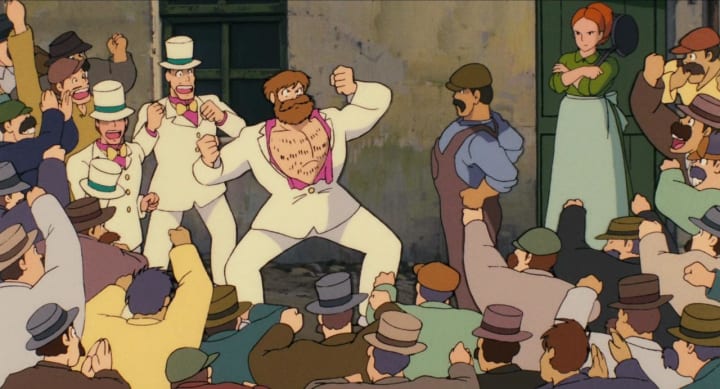
Despite Pazu’s youthfulness, he is visibly seen as an asset to the community, leading a clear example of Miyazaki’s vision – but this does not end with the protagonists. He also has a history of being influenced by grandeur landscapes in locations around the world, typically drawn to terrains that suit the curated storyline that he envisions for said protagonists to traverse.
Furthermore, Miyazaki pays homage to the beauty of Wales in Castle in the Sky, by incorporating the rolling valleys of Rhondda, a pinnacle destination on this scouting mission that captured his attention, modelling the cliffs and mountains seen within the film. Noting this attention to detail when it comes to nature is crucial, for a portion of Miyazaki’s efforts when creating beautiful scenes stems from Shinto, a Japanese religion that values the depth of nature.
It is widely known that, under Miyazaki’s influence, the Studio Ghibli franchise illustrates the harmonious yet fragile relationship of humans and nature. Specifically highlighting the wisdom of youth, the protagonists of the films are most often children set on an adventure to uncover something greater than themselves. Examples can be found in Princess Mononoke (1999) that features the deterioration of harmony between humans, animals and gods.
However, Castle in the Sky spins this ideology on its head for it is composed of three main elements that take the mechanisms of cinema’s ability to utilize knowledge of the past, leading to the portraying of revitalized morals on a larger scale, consumable for all ages.
Firstly, Miyazaki is notoriously known for despising any form of war and conflict. His films have a solid track record of harbouring anti-war statements. Some Ghibli films will portray greedy characters with a strong desire to obtain wealth or power as the villains, with children as the leading protagonists. This speaks in volumes to the notion of what happens when power falls into the wrong hands and how Miyazaki views children as the future empowerment of the earth.
Speaking of the notion of power, Castle in the Sky heavily relies on conveying the vitality of Laputa’s power in the form of a crystal, Volucite. In the film, Sheeta and Pazu are on a mission to find the lost city in the sky, while protecting it from outside forces bent on abusing its magical power. Although it is not stated, the concept of acknowledging the impact and consequences surrounding nuclear power is visible within the film.
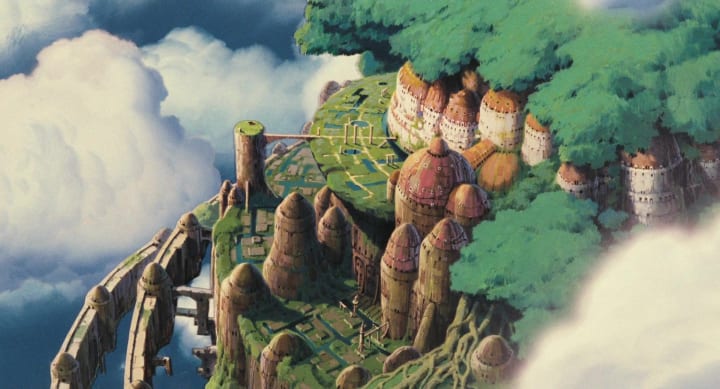
To add to the looming complexities of the world of Laputa, there are giant robots which act as protectors of Laputa and Sheeta, using destructive measures to keep enemies at bay. Castle in the Sky offers a rich exploration into the harmony of Laputa, an abandoned world consumed by nature and cared for by the remnants of its robot inhabitants, while a human war rages below in efforts to abuse the world’s existence and power for financial and political gain.
Laputa is described as a lost civilization, but the element of nuclear technology threaded throughout its origins is a vital aspect of Miyazaki’s style, evoking a multitude of connections to Cold War politics within Castle in the Sky. To add to the historical context of the film’s timely release, the 1980’s saw the number of nuclear warheads worldwide reach approximately 70,000. The battle for power represented in Castle in the Sky is one of classic good vs. evil.
In relation to international politics; the film’s government identity represents the height of the desire for power, which is based upon human idealism, the idea that humans are the only sentient beings in existence, while Sheeta and Pazu represent the cooperation for peace upon classical liberalism and an emphasis on freedom.
Establishing the two sides of this battle is critical in breaking down the incredible power that Laputa truly possesses. The power of the crystal is depicted in the care of how it is harboured within the centre of Laputa, locked away and close to the heart of the floating city.
One rogue agent, who wishes to collect the power of Laputa solely for himself, performs a series of tests, abusing the extent of the Volucite's power. These tests symbolize the nuclear testing of atomic bombs, a striking element to be included in the film during the time of the Cold War.
Now, this power is supported by a mountainous tree, an emblem of nature, in order to lend strength to the castle within Laputa, which is a product of humanity’s technology. Nature lends itself to fuel technology, time’s oldest life source being poured into the humans’ greatest creation.
In retrospect to Miyazaki’s films that play on the idea of the consequences or lessons that may be born from the harmony of fabrication and nature, these films depict ecosystems with richer realities than ever previously assumed.
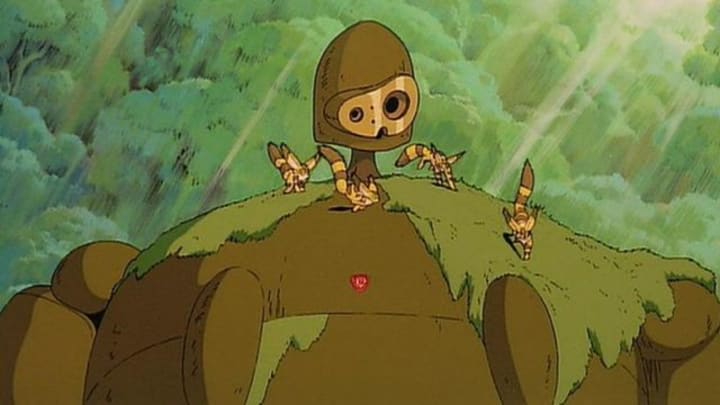
In The Machine in the Garden (1964), Marx analyzes the interior of the psyche, in connection to the changes of a physical environmental landscape. This plays into shinto, for it could possibly represent a deeper and more intimate connection into how nature affects humans and vice versa. Castle in the Sky acts as a catalyst for recognizing the relationships that humans have with both technology and nature.
Throughout the extensive study of the human-nature relationship, the factors of environment and landscape become intertwined. Laputa can be described as a landscape, especially after the civilization that once inhabited it had gone extinct, aside from the robots. However, even then, their presence is not promised for they are also deteriorating slowly. This can be attributed to the notion of cultural and natural marks left on a landscape such as Laputa.
It can be inferred that the civilization that once inhabited Laputa is responsible for its floating apparatus-like appearance, harnessing the power of a natural crystal that can only be wielded by those descendants of the world.
The rich culture and history of Laputa stems from a humanity taking from the elements and justly creating with its aid, however, it is demonstrated as a peaceful and harmonious relationship. An example of how human interaction with nature benefitted both the ecosystem and the civilization.
Furthermore, the giant robots do not only exist to protect Laputa, but also were designed to take care of the world, which is evident in the robot’s gentle and caring nature when looking after Laputa’s diverse and lush wildlife, flora and fauna, and relics.
Laputa becomes an entity akin to a forest or an abundance of wilderness, which Miyazaki envisions as a spiritual essence within Ghibli films. Miyazaki’s films highlight the spiritual relationship between nature and humans, which prompts the principles of taking care of the environment, making it a habitable space and giving back to what it offers humanity as a whole.
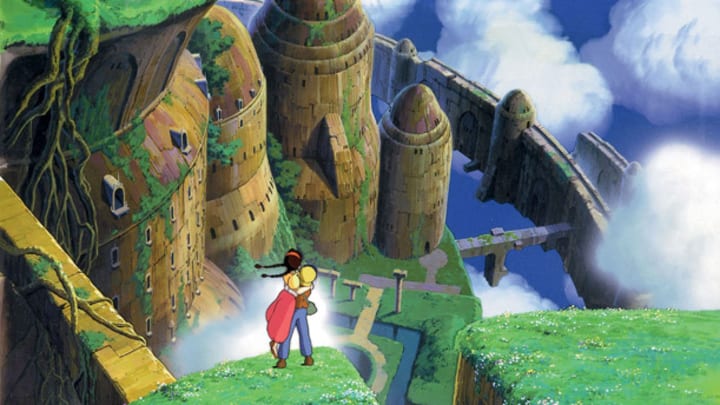
In conclusion, Castle in the Sky may depict a fictional world filled with magic, but could not represent the relationships of humanity, technology and nature more clearly. Despite the era of the film’s release, it is still prudent to acknowledge within today’s political and ecological climate.
The tales of Laputa ran rampant across the mining village Pazu grew up in, with only hearsay to back up the incredible possibilities of a whole world balancing in the sky. There was little to be understood about its abandonment, one could say the civilization grew too reliant on technology, and once humanity came to extinction, Myazaki demonstrated through this film the longevity of nature.
He demonstrated how humanity’s touch affects how technology is crafted in relation to the very defiance of nature. The constant battle between humans, nature and machines is an ever growing precedent, but this battle is nothing less than the relationships of entities co-existing by default.
Miyazaki provides enlightened insight into how this relationship is as willful as a beating heart, and as valuable to comprehend as the inner workings of the mind.
Thanks for reading!
b.d
About the Creator
bree duwyn
24-year-old journalism graduate currently in south korea
writer & café enthusiast
i have an affinity for film, music and literature.
Reader insights
Nice work
Very well written. Keep up the good work!
Top insights
Expert insights and opinions
Arguments were carefully researched and presented
Easy to read and follow
Well-structured & engaging content
Eye opening
Niche topic & fresh perspectives
Heartfelt and relatable
The story invoked strong personal emotions
Excellent storytelling
Original narrative & well developed characters
Compelling and original writing
Creative use of language & vocab
Masterful proofreading
Zero grammar & spelling mistakes







Comments (12)
Love "Castle in the Sky" !!!
Intresting
GREAT POST
Cool 😎 👍
Wonderful article!
Now I’m going to watch these! Thank you!
This is an excellent analysis of Miyazaki's work in the film. I feel as though I have a much deeper understanding of the metaphors in his films.
I'm absolutely obsessed with your brain and the way you think about things in a broader picture.
Hearted and subscribed
Excellent I love these films and I enjoyed your perspective
Great topic for your first article published here.
I remember seeing this movie during the Ghibli Fest. Great coverage and description of key elements of this masterful movie.